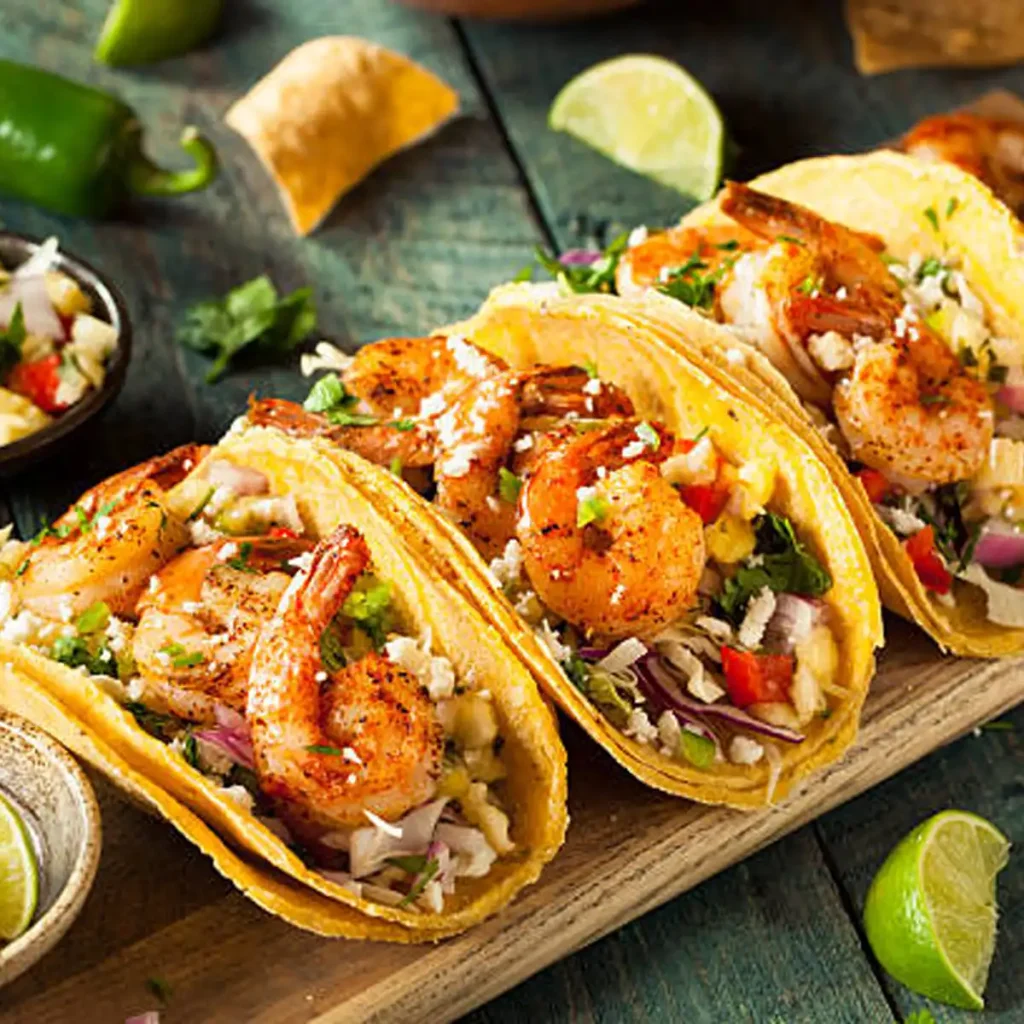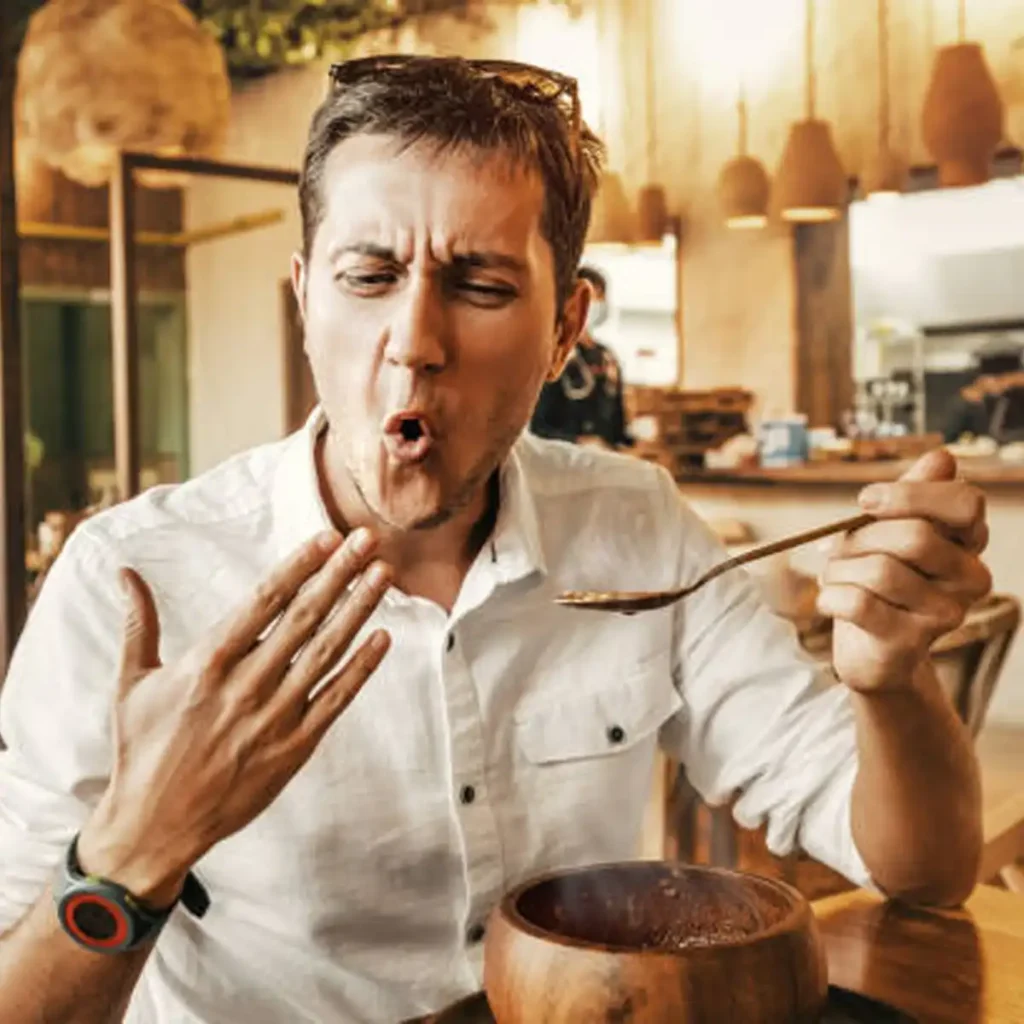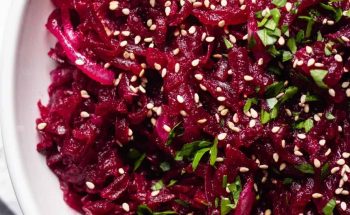Spicy food breaks a rule that keeps most mammals safe. The same compound that tells the body to pull away from a flame is the compound many people now seek in dinner. Why do people like spicy food is not a throwaway question. It points to how sensation, reward, culture, and identity intersect on the plate. Psychologist Paul Rozin described a useful idea called benign masochism. The body sounds a false alarm, yet the conscious brain knows there is no burn to the tissue. Mastery over that signal feels rewarding. Personality research supports this. People who enjoy heat tend to score higher on the sensation-seeking scale. That helps explain the appeal of hot wing contests and the private pride that comes with handling a vindaloo.
There is also a plausible biological payoff. Intense oral pain can trigger the release of endorphins and dopamine. Animal studies show that capsaicin can increase beta-endorphin levels in cerebrospinal fluid and upregulate POMC in the hypothalamus. That offers a pathway for the familiar endorphin rush from spicy food. Yet the long view is not settled. A 2022 study in adolescents linked frequent spicy food with higher reports of anxiety and depression. This does not prove cause. It does warn against simple claims that chillies improve mood over time. The thrill is likely acute. The net effect on mood needs more research.
Clarifies What Capsaicin Does In The Body
From a mild jalapeño to a Carolina Reaper, one molecule drives the burn. Capsaicin locks onto TRPV1, a receptor tuned to high heat. Once bound, the ion channel opens and calcium floods into the nerve ending. The brain reads that signal as burning pain. TRPV1 activation also prompts local release of neuropeptides such as Substance P and CGRP, causing vasodilation and the flushed warmth many people feel.
The paradox sits in desensitisation. Repeated exposure makes TRPV1 less responsive. This one process explains rising tolerance in regular chilli eaters. It also explains why topical capsaicin can reduce pain in arthritis or neuralgia. NHS products such as Zacin and Axsain use this principle. Drug makers once chased TRPV1 blockers, but trials ran into safety problems, including hyperthermia and burn injuries from impaired heat sensing. The lesson is simple. TRPV1 is part of a core safety circuit. Turning it off entirely is unsafe. Using capsaicin itself to desensitise the circuit remains the viable route.
Shows How Heat Is Measured Without Hype
Scoville Heat Units were first determined by human tasters in 1912. That organoleptic method gave the world a common language, but modern labs now use HPLC to quantify capsaicinoids with precision. Results appear as parts per million of heat and are converted back to SHU for continuity using a published factor. Pure capsaicin sits around 15-16 million SHU. Labels tell only part of the story. Pungency varies by cultivar, ripeness, and growing conditions. A fully red Capsicum chinense will dwarf a green Capsicum annuum, and a warm season can push levels higher than a cool one.
Weighs The Clinical Evidence So You Can Decide
Health claims around chillies span weight control, cholesterol, blood sugar, gut health, and antimicrobial effects. The safest stance is evidence first.
Identifies What Helps With Weight
Two mechanisms matter here. Thermogenesis and satiety. A 2019 meta-analysis pooled 13 trials and found a roughly 34 kcal/day increase in resting metabolic rate with capsaicinoid supplementation. The figure is real, but it is modest. It will not replace movement or diet quality. The satiety data looks more useful. Trials show higher fullness and lower ad lib energy and fat intake after exposure to capsaicin, especially when the mouth senses it. That points to a sensory feedback loop. In practice, pairing heat with balanced meals may help people feel satisfied with fewer calories. Does spicy food help with weight loss often tops search results. The balanced answer is yes in a supporting role, and only as part of a broader plan.
Explains The Cardiovascular Picture
The strongest human data sits in lipid changes among people with metabolic syndrome. A 2022 meta-analysis of nine RCTs with 461 participants found reductions in total cholesterol and LDL cholesterol with capsaicin. No overall effect was observed for HDL or triglycerides, though subgroup analysis suggested triglyceride reductions in women and in shorter trials. The direction of travel is encouraging. For people building a heart-healthy pattern, chilli health benefits for cholesterol are worth noting, while keeping expectations realistic.
Clarifies Blood Sugar Findings
Preclinical studies are positive. Human trials are not. A 2021 systematic review across 14 trials concluded that capsaicin did not produce acute or chronic changes in blood glucose or insulin levels in people. That aligns with smaller trials in healthy adults. For a health-conscious reader, the conclusion is clear. Capsaicin is not a tool for glycaemic control at this time. Is spicy food good for diabetes should be answered with caution and a focus on proven strategies such as fibre intake, activity, and weight management.
Describes The Gut And Antimicrobial Story
In vitro studies show that capsaicin can inhibit pathogens, including Helicobacter pylori and Streptococcus pyogenes. Animal studies suggest a second mechanism through the microbiome. A 2017 mouse study reported that capsaicin prevented high-fat diet-induced obesity and inflammation by shifting gut flora toward beneficial butyrate producers and away from LPS producers. The effect transferred by faecal transplant, indicating the microbiome as the driver. Human confirmation is not yet robust, but the direction is promising for gut microbiome and spicy food.
Lists The Risks So You Can Use Heat Safely
Covers The Common Gastrointestinal Effects
Even small capsule doses near 0.5 mg can trigger abdominal burning, pressure, and fullness in healthy adults. People with IBS or NERD often report stronger symptoms. That is not fussiness. Studies show higher TRPV1 expression in the gut mucosa of these patients, which heightens the signal. In GERD, capsaicin may not increase acid exposure, yet it can intensify and hasten heartburn sensations after meals. The practical step is to respect symptoms, eat with buffers such as rice or bread, and avoid very hot dishes on an empty stomach.
Busts Two Persistent Myths
Ulcers are driven mainly by H. pylori or long term NSAID use. Spicy food does not cause ulcers and may even help lower acid output and support the gastric lining. Chillies do not cause haemorrhoids either. They can, however, set off pain if fissures are present, because exposed TRPV1 receptors react to capsaicin on contact.
Fun fact: Birds do not feel the burn. Due to mutations in their TRPV1 receptor, birds can eat chillies without pain and spread seeds over long distances, helping the plants thrive.
Sets Out The Rare But Serious Dangers
Superhot challenges are not only a game. Case reports link extreme intake to vascular events. A 2018 BMJ Case Reports paper described thunderclap headaches and reversible cerebral vasoconstriction syndrome after a Carolina Reaper eating contest. Separate reports connect cayenne pills with coronary vasospasm and acute myocardial infarction in young adults without prior disease. The risk is rare, yet real, and rises with dose. Carolina Reaper side effects should be understood before anyone attempts a challenge.
Flags Groups And Drugs That Need Extra Care
Pregnancy and breastfeeding appear low risk for normal dietary use, and topical products are poorly absorbed. Children can eat moderate chilli, but topical creams require clinical oversight. Inhalation of aerosolised capsaicin is unsafe for anyone.
Drug interactions deserve attention. Capsicum can slow clotting. Combined with anticoagulants or antiplatelets such as warfarin, apixaban, aspirin, or other NSAIDs, the risk of bruising and gastrointestinal bleeding can increase. Many older adults take low-dose aspirin. Layering high spice intake on top can compound risk. ACE inhibitors can cause a dry cough, and there is a report of capsaicin making that cough worse. People on these medicines should keep heat moderate and discuss symptoms with a clinician.


Traces The Bigger Story From Evolution To London
Explains Why Plants Built Heat And Why People Still Eat It
Capsaicin evolved as a targeted defence. Mammals crush seeds with molars. Pain keeps them away. Birds swallow seeds whole and spread them intact. Avian TRPV1 does not respond to capsaicin. Humans are the exception. We kept the pain receptor and built a culture that sometimes celebrates triggering it. Another mammal, the Chinese tree shrew, eats spicy plants, but it carries a TRPV1 mutation that makes it less sensitive to them. People are unusual not because we miss the pain, but because we sometimes choose it and learn to enjoy it.
Locates The Trend In Today’s UK Food Culture
Chillies anchor cuisines worldwide. Consumption and production figures vary by country, but the direction is steady growth. In the UK, demand for bold flavours has risen as home cooks experiment with global dishes. Surveys report high interest in food with some heat. Younger diners, including Gen Z and Millennials, drive part of this expansion, with many carrying hot sauce as a personal staple. Street food has accelerated exposure to authentic regional chilli profiles and techniques. The result is a market where the best hot sauce UK and authentic Sichuan in London are common searches, and where specialist retailers and makers now thrive.
Gives London Shoppers Clear Paths To Quality
Recommends Where To Buy Fresh And Dried
Londoners can move well beyond Bird’s Eye. For dried Mexican varieties such as ancho, pasilla, mulato, and chipotle, Mestizo Market in Euston is a strong choice. For fresh Scotch Bonnets, Ghost peppers, and regional specialities, Ridley Road Market in Dalston and diverse grocers around Turnpike Lane and Wood Green are reliable. Turkish and Middle Eastern peppers, pastes, and flakes are easy to find at TFC in Dalston and independent shops along Essex Road in Islington. Artisan hot sauces appear at retailers like Nourished Communities, and The Rib Man’s market stall on Brick Lane is a local reference point. For superhots such as Carolina Reapers and Nagas, UK online specialists, including One Stop Chilli Shop and East Coast Chilli Company, supply seasonal stock.
Points To Where To Taste Heat With Depth
London hosts benchmarks for layered heat rather than gimmicks. Barshu in Soho serves mála with balance and intensity, showing how fragrant chillies and Sichuan pepper deliver fire and tingling together. Peppers & Spice in Dalston offers a masterclass in Scotch Bonnet flavour that builds and lingers with fruit and smoke. Namak Mandi in Tooting shows how South and Central Asian cooks weave fresh green chillies into the dish itself for integrated heat. Mestizo in Euston demonstrates how dried chillies give depth, fruit, and smoke, with heat as a warm undertone. Food festivals add range. Hot Sauce Society in Peckham focuses on craft producers. Chilli Fest at Fulham Palace blends tastings with competitions. Taste of London in Regent’s Park brings many restaurants to one place for a broad survey.
Helps You Cook With Confidence At Home
Selects Chillies By Flavour Not Only Heat
Treat chilli as a flavour ingredient. Green jalapeños are bright and crisp. As fruits ripen, sweetness and fruit notes rise. Chipotle brings smoke and earth. Scotch Bonnet delivers high fruit and a sharp, clean burn. Habanero leans floral and citrus. Ghost pepper builds slowly with deep fruit. Carolina Reaper adds intense fruit and an overwhelming peak. Pair bright green heat with avocado, lime, tomato, and cheese. Pair smoky chipotle with adobo, pork, and beans. Scotch Bonnet belongs with jerk seasoning, mango, and allspice. Habanero suits salsas and marinades with tropical fruit. Ghost pepper works in chutneys and stews that can carry a slow build. For extreme heat sauces, Reaper is usually best left to measured drops.
Lays Out Safe Handling For Superhots
Gloves are mandatory once you move past jalapeños. Capsaicin is an oil and causes contact burns. Use nitrile gloves and change them if torn. Keep a dedicated board and knife to prevent cross-contamination, and open a window or run an extractor. Never blend or process superhots with blades. Aerosolised capsaicin can trigger severe coughing, laryngospasm, and respiratory distress. Clean surfaces with washing-up liquid, an alcohol-based cleaner, or diluted bleach. Water alone spreads the oil.
Teaches Fast Relief And Prevention
Water is the wrong choice once your mouth catches fire. Capsaicin is fat-soluble. The right approach uses dairy. Milk and yoghurt help because casein behaves like a detergent that lifts capsaicin from receptors, and fat dissolves what remains. Research suggests protein is key, so skimmed milk can work as well as whole milk. Sugar can distract receptors and reduce perceived burn. Acidic drinks such as lemonade or lime juice may help neutralise. Prevent gut distress by eating spicy food with fat or soluble fibre such as rice, bread, or banana, and avoid an empty stomach. Know your limits if you have a sensitive gut. How to stop chilli burn is a common query. The short answer is milk or yoghurt first, then time.
Summarises Regulation And First Aid
UK food law does not set a hard cap on capsaicin in food. Products must not be harmful to health. German guidance in 2023 advised caution, noting that mild adverse effects such as heartburn can begin as low as 0.5 to 1 mg. The UK Food Standards Agency has focused on adulteration risks such as illegal Sudan dyes in imported powders.
Follow the NHS-based first aid for exposure. Treat skin contact as a chemical burn. Brush off dry powder and run cool or lukewarm water for at least 20 minutes. Eye exposure is an emergency. Rinse continuously and go to A&E. If you inhale aerosolised capsaicin and develop coughing, wheeze, or shortness of breath, seek urgent care.
Reaches A Practical Verdict You Can Use Today
People are the sole species that can recognise a pain signal from TRPV1 and still decide to seek it. Culture, thrill seeking, and a credible endorphin pathway can make heat feel good. That does not make chilli a cure all. The best-supported benefits rest in satiety and modest thermogenesis for weight management, and in improvements in LDL cholesterol and total cholesterol in people with metabolic syndrome. Early microbiome signals are intriguing and deserve careful human trials. Risks exist on a continuum. For most, they are limited to short-lived gastrointestinal discomfort. For people with IBS, the sensitivity is biological and should be respected. For anyone on anticoagulants or antiplatelet agents, caution is prudent due to a higher bleeding risk. Extreme doses in challenges can cause rare but severe vascular events.
Use chilli as a potent and flavourful ingredient. Build dishes around its grassy, fruity, and smoky notes. Keep superhots for small touches. Prioritise pleasure, respect your own threshold, and keep safety steps close at hand. In plain terms, let heat serve your health, not the other way round. As a closing thought, the old saying fits: look after the pennies and the pounds will look after themselves. Small, steady habits bring the greatest return.





